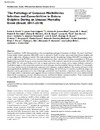Please use this identifier to cite or link to this item:
https://accedacris.ulpgc.es/jspui/handle/10553/77716
| Title: | The Pathology of Cetacean Morbillivirus Infection and Comorbidities in Guiana Dolphins During an Unusual Mortality Event (Brazil, 2017-2018) | Authors: | Groch, K. R. Diaz Delgado, Josue Santos-Neto, E. B. Ikeda, J. M. P. Carvalho, R. R. Oliveira, R. B. Guari, E. B. Flach, L. Sierra Pulpillo, Eva María Alves Godinho,Ana Fernández Rodríguez, Antonio Jesús Keid, L. B. Soares, R. M. Kanamura, C. T. Favero, C. |
UNESCO Clasification: | 3105 Peces y fauna silvestre 240119 Zoología marina 310907 Patología |
Keywords: | Guiana dolphin Paramyxoviridae Sotalia guianensi Toxoplasma gondii Cetacean morbillivirus, et al |
Issue Date: | 2020 | Journal: | Veterinary Pathology | Abstract: | Cetacean morbillivirus (CeMV; Paramyxoviridae) is the most significant pathogen of cetaceans worldwide. The novel “multi-host” Guiana dolphin (Sotalia guianensis; GD)-CeMV strain is reported in South American waters and infects Guiana dolphins and southern right whales (Eubalaena australis). This study aimed to describe the pathologic findings, GD-CeMV viral antigen distribution and detection by RT-PCR (reverse transcriptase polymerase chain reaction), and infectious comorbidities in 29 Guiana dolphins that succumbed during an unusual mass-mortality event in Rio de Janeiro state, Brazil, between November 2017 and March 2018. The main gross findings were lack of ingesta, pulmonary edema, ascites, icterus, hepatic lipidosis, multicentric lymphadenomegaly, as well as pneumonia, polyserositis, and multiorgan vasculitis caused by Halocercus brasiliensis. Microscopically, the primary lesions were bronchointerstitial pneumonia and multicentric lymphoid depletion. The severity and extent of the lesions paralleled the distribution and intensity of morbilliviral antigen. For the first time in cetaceans, morbilliviral antigen was detected in salivary gland, optic nerve, heart, diaphragm, parietal and visceral epithelium of glomeruli, vulva, and thyroid gland. Viral antigen within circulating leukocytes suggested this as a mechanism of dissemination within the host. Comorbidities included disseminated toxoplasmosis, mycosis, ciliated protozoosis, and bacterial disease including brucellosis. These results provide strong evidence for GD-CeMV as the main cause of this unusual mass-mortality event. | URI: | https://accedacris.ulpgc.es/handle/10553/77716 | ISSN: | 1544-2217 | DOI: | 10.1177/0300985820954550 | Source: | Veterinary Pathology [E1544-2217], v. 57 (6), p. 845-857 |
| Appears in Collections: | Artículos |
WEB OF SCIENCETM
Citations
25
checked on Jun 8, 2025
Page view(s)
141
checked on Oct 26, 2024
Download(s)
484
checked on Oct 26, 2024
Google ScholarTM
Check
Altmetric
Share
Export metadata
Items in accedaCRIS are protected by copyright, with all rights reserved, unless otherwise indicated.
